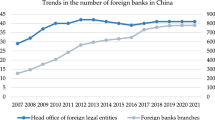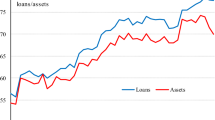Abstract
Structural monetary policy and macro-prudential policies are important parts of the policy system of the People’s Bank of China. By constructing a dynamic stochastic general equilibrium model that includes the heterogeneity of corporate and bank credit, the authors divide the policies of the People’s Bank of China into seven categories, and explores the policy effectiveness of structural monetary policy, macro-prudential policy and traditional aggregate monetary policy. Through simulation of the model, it is found that whether facing technical shocks, interest rate shocks or credit shocks, the structural two-pillar policy tool that uses the deposit reserve interest rate as the target of operation is most conducive to economic stability. Technological progress has the most positive and lasting impact on output. Interest rates and credit policies will leave follow-up problems in the adjustment of the economy, and structural two-pillar policies can alleviate the impact of these problems.
Similar content being viewed by others
References
Gelain P and Dmitry K, An estimated dynamic stochastic general equilibrium model with financial frictions for estonia, Eastern European Economics, 2011, 49: 97–120.
Behigno P and Salvatore N, International portfolio allocation under model uncertainty, American Economic Review, 2012, 4: 144–189.
Tavman Y, A comparative analysis of macroprudential policies, Oxford Economic Papers, 2015, 67: 334–355.
Carrera C and Vega H, Interbank market and macroprudential tools in a DSGE model, Banco Central De Reservadel Peru, 2012, 23: 145–180.
Alpanda S and Zubairy S, Adressing household indebtedness: Monetary, fiscal or macroprudential policy?, European Economic Review, 2017, 92: 47–73.
Ian C, Césaire M, and Kevin M, Bank leverage regulation and macroeconomic dynamics, Bank of Canada, 2011, 32: 43–86.
Angeloni I and Faia E, Capital regulation and monetary policy with fragile banks, Journal of Monetary Economics, 2013, 60: 311–324.
Collard F, Dellas H, Diba B, et al., Optimal monetary and prudential policies, Amercian Economic Journal: Macroeconomics, 2017, 9: 40–87.
Gelain P and Ilbas P, Monetary and macroprudential policies in an estimated model with financial intermediation, Journal of Economic Dynamics & Control, 2017, 78: 164–189.
Kiley M T and Sim J, Optimal monetary and macroprudential policies: Gains and Pitfalls in a model of financial intermediation, Journal of Macroeconomics, 2017, 54: 232–259.
Bitar J, Foreign currency intermediation: Systemic risk and macroprudential regulation, Latin American Journal of Central Banking, 2021, 2(2), DOI: https://doi.org/10.1016/j.latcb.2021.100028.
Freixas X and Perez-Reyna D, Optimal macroprudential policy and rational bubbles, Journal of Financial Intermediation, 2021, 46(3): 100908.
Ma Y and Cheng Y, Coordination and matching of macro-prudential policies: A simulation analysis based on China, Journal of Financial Research, 2013, 8: 57–69.
Zhang M and Wang W, Research on the effectiveness of China’s macroprudential policy rules based on the DSGE model: From the perspective of loan-to-value ratio, Shanghai Finance, 2014, 3: 68–72, 118.
Fang Y, Research on the effectiveness of macro-prudential policies, The Journal of World Economy, 2016, 39: 25–49.
Zhang M and Lin H, Research on the coordination and cooperation of the two-pillar control policy of “Monetary Policy + Macro-Prudent Policy” based on the DSGE model, Shanghai Finance, 2017, 12: 3–9.
Wang H and Wang Y, Research on the dual-pillar control of currency and macro-prudential policies in response to asset price fluctuations under the new economic normal, Commercial Research, 2018, 9: 63–73.
Cheng F and Meng W, Coordination of macro-prudential policy and monetary policy: DSGE model based on Bayesian estimation, Chinese Journal of Management Science, 2017, 25: 11–20.
Zhao S and Zhang H, Research on the coordination of China’s macro-prudential policy and monetary policy: Based on the asymmetry effect of house price volatility, Studies of International Finance, 2018, 7: 11–22.
Qu L, Xu W, and Qian G, Research on the effectiveness of channel arbitrage supervision under the macro-prudential framework: Analysis based on the DSGE model, Financial Economics Research, 2019, 34(3): 10–22.
Deng X and He R, The financial stability effect and optimal rules of macro-prudential policy’s research based on the multi-sector DSGE model, Shanghai Journal of Economics, 2021, (5): 76–88.
Jin C and Dong X, Research on the effective combination of China’s monetary policy and macro-prudential policy under the “double pillar” policy framework, Modern Economic Research, 2021, (4): 56–65.
Gu H and Ma C, Government regulation, market restriction, and bank risk-taking: Evidence from 178 commercial banks in China, Financial Economics Research, 2020, 35(1): 117–130.
Calvo G A, Staggered prices in a utility-maximizing framework, Journal of Monetary Economics, 1983, 12(3): 383–398.
Da Z, Can structural monetary policy relieve the financing difficulties of small businesses, Financial Economics Research, 2020, 35(2): 51–62.
Jiang H and Zhan L, Capital supervision, market competition and bank loan structure, Financial Economics Research, 2020, 35(1): 67–80.
Guo N and Zhou Y, House price fluctuations, macro-prudential supervision and optimal monetary policy choice, Nankai Economic Studies, 2019, 2: 186–206.
Guo Y, Cheng W, and Chen Y, Research on the decline of China’s monetary policy effectiveness and expectation management, Economic Research Journal, 2016, 51(1): 28–41, 83.
Li X, Dynamic Stochastic General Equilibrium Model Theory, Method and Dynare Practice, Tsinghua University Press, Beijing, 2018.
Peng Y and Fang Y, Structural monetary policy, industrial structure upgrading and economic stability, Economic Research Journal, 2016, 51(7): 29–42, 86.
Guo Y, Guo J, and Xiao Z, Research on China’s optimal monetary policy under the dual-track interest rate system, Economic Perspectives, 2016, 3: 31–42.
Meng X, Zhang Q, and Li T, Research on optimal monetary policy rules under the background of China’s economic “removal of reality to virtuality”, The Journal of World Economy, 2019, 42(5): 27–48.
Luo N and Cheng F, Analysis of the coordination effect of macro-prudential policy and monetary policy of house price volatility: Based on the DSGE model of new Keynesianism, Studies of International Finance, 2017, 1: 39–48.
Cheng G, Jiang X, and Zhao X, Monetary policy, macro-prudential supervision and banking systematic risk assumption, Systems Engineering — Theory & Practice, 2020, 40(6): 1419–1438.
Bian Z and Guan Z, A forward-looking perspective analysis of optimal monetary policy rules, Journal of Financial Research, 2005, 9: 31–38.
Author information
Authors and Affiliations
Corresponding authors
Additional information
This research was supported by High-level Talent Project of Basic and Applied Basic Research Program (Natural Science Field) of Hainan Province under Grant No. 2019RC065, the National Natural Science Foundation of China under Grant No. 71963011, Philosophy and Social Science Planning Project of Hainan Province under Grant Nos. HNSK(ZD) 19-108 and HNSK(QN)18-10.
This paper was recommended for publication by Editor ZHANG Xinyu.
Rights and permissions
About this article
Cite this article
Kuang, X., Wang, Q. & Chen, X. The Effectiveness of Structural Monetary Policy and Macro-Prudential Policies — Based on the DSGE Model That Includes Bank Heterogeneous Credit. J Syst Sci Complex 34, 2267–2290 (2021). https://doi.org/10.1007/s11424-021-1096-y
Received:
Revised:
Published:
Issue Date:
DOI: https://doi.org/10.1007/s11424-021-1096-y




